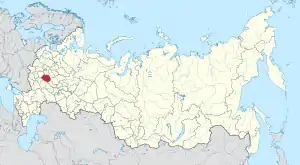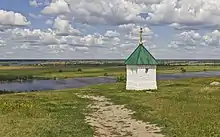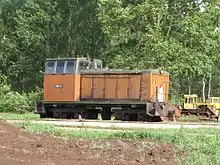Ryazan Oblast
Ryazan Oblast (Russian: Ряза́нская о́бласть, tr. Ryazanskaya oblast, IPA: [rʲɪˈzanskəjə ˈobləsʲtʲ]) is a federal subject of Russia (an oblast). Its administrative center is the city of Ryazan, which is the oblast's largest city.
Ryazan Oblast | |
|---|---|
| Рязанская область | |
 Flag  Coat of arms | |
 | |
| Coordinates: 54°24′N 40°36′E | |
| Country | Russia |
| Federal district | Central[1] |
| Economic region | Central[2] |
| Administrative center | Ryazan |
| Government | |
| • Body | Oblast Duma[3] |
| • Governor[3] | Pavel Malkov[4] |
| Area | |
| • Total | 39,600 km2 (15,300 sq mi) |
| • Rank | 58th |
| Population (2010 Census)[6] | |
| • Total | 1,154,114 |
| • Estimate (2018)[7] | 1,121,474 (−2.8%) |
| • Rank | 45th |
| • Density | 29/km2 (75/sq mi) |
| • Urban | 70.9% |
| • Rural | 29.1% |
| Time zone | UTC+3 (MSK |
| ISO 3166 code | RU-RYA |
| License plates | 62 |
| OKTMO ID | 61000000 |
| Official languages | Russian[9] |
| Website | http://www.ryazangov.ru |
Geography
Ryazan Oblast borders Vladimir Oblast (N), Nizhny Novgorod Oblast (NE), the Republic of Mordovia (E), Penza Oblast (SE), Tambov Oblast (S), Lipetsk Oblast (SW), Tula Oblast (W), and Moscow Oblast (NW).
In terms of physical geography, Ryazan Oblast lies in the central part of the Russian Plain between the Central Russian and Volga uplands. The terrain is flat, with the highest point of no more than 300 m above sea level. Soils are podzolic and boggy on the left bank of the Oka, changing southward to more fertile podzolic and leached black-earths (chernozyom).
Hydrography

Most of the Ryazan Oblast lies within the Volga basin, with the Oka the principal river of the area.
History
Human occupation of the area of the Ryazan Oblast dates from at least the Upper Paleolithic period. East Slavs, Volga Finnic, Tatar tribes inhabited the area and merged into an ethnos, a process virtually completed by the 13th century CE. In 830 the Ryazan area became part of Rus' Khaganate.
Later the Ryazan area became part of the Kievan Rus' political system and came under the domination of the Principality of Chernigov (founded in 988). The Principality of Ryazan operated as a separate entity from 1097 to 1521, when the area became part of the Grand Duchy of Moscow, though with the Qasim Khanate district retaining some autonomy until the 1550s.
The Ryazan Governorate became separate from the Moscow Governorate in 1796.
Soviet Union
Ryazan Oblast was formed out of the Moscow and Voronezh oblasts in 1937. It took its present form in 1954 when some of its southern districts were ceded to the newly established Lipetsk Oblast. Also in 1954, it was ceded parts of southern Moscow Oblast and no border changes happened afterward.
Administrative divisions
Economy

Soviet Union
In the post-war period of the Soviet Union recovery in the wake of growing competition between USSR and US several ambitios plans severely undermined economical stability of the region. In Ryazan Oblast, at the behest of central government led by Nikita Khrushchev a regional administration ordered slaughter of livestock in a futile attempt to boost productivity rates (plans included tripling of meat and milk production). Because of series of misjudgement and overestimations these plans resulted in disastrous failure which is known today as Ryazan miracle (Russian: Рязанское чудо).
Modern
Ryazan Oblast is a part of the Central economic region. The oblast is economically favorable due to the water and land routes that pass through it and provide stable domestic and foreign economic ties. It is considered both an industrial and agricultural Oblast. The agriculture in the region is represented by livestock farming and plants cultivation. Livestock farming specializes in raising and fattening cattle and breeding pigs, sheep, and poultry. Beekeeping is also well developed in the region.
Transportation
- Solotchinskoye peat narrow gauge railway is located in Ryazansky District
- Mesherskoye peat narrow gauge railway is located in Klepikovsky District
Demographics
Population: 1,154,114 (2010 Census);[6] 1,227,910 (2002 Census);[11] 1,345,924 (1989 Census).[12]
- 2012
- Births: 12 351 (10.8 per 1000)
- Deaths: 18 723 (16.3 per 1000)[13]
- Total fertility rate:[14]
- 2009 - 1.42 | 2010 - 1.44 | 2011 - 1.45 | 2012 - 1.54 | 2013 - 1.55 | 2014 - 1.60 | 2015 - 1.64 | 2016 - 1.70(e)
Ethnic composition (2010):[6]
- Russians - 95.1%
- Ukrainians - 0.8%
- Armenians - 0.5%
- Mordvins - 0.5%
- Tatars - 0.5%
- Azeris - 0.4%
- Uzbeks - 0.3%
- Others - 1.9%
- 74,419 people were registered from administrative databases, and could not declare an ethnicity. It is estimated that the proportion of ethnicities in this group is the same as that of the declared group.[15]
Religion
According to a 2012 survey[16] 63% of the population of Ryazan Oblast adheres to the Russian Orthodox Church, 3% are unaffiliated generic Christians, 1% are Orthodox Christian believers without belonging to church or belonging to non-Russian Orthodox churches, 1% are Muslims, and 1% are adherents of the Rodnovery (Slavic native faith) movement. In addition, 15% of the population declares to be "spiritual but not religious", 9% is atheist, and 7% follows other religions or did not give an answer to the question.[16]
Tourism
- Eurleno Mansion, an 18th century mansion built by wealthy local trader and farmer.
Notable people
Arts
- Alexander Alexandrov (1883–1946), composer
- Erast Garin (1902–1980), comic actor
- Alexander Genis (born 1953), writer, broadcaster and cultural critic
- Yuri Kholopov (1932–2003), musicologist, music theorist, doctor of arts, and professor of the Moscow Conservatoire
- Maximilian Kravkov (1887–1937), writer
- Andrei Mironov (born 1975), painter
- Konstantin Paustovsky (1892–1968), writer
- Alexander Pirogov (1899–1964), bass opera singer
- Yakov Polonsky (1819–1898), writer
- Mikhail Saltykov-Shchedrin (1826–1889), satirist
- Aleksandr Solzhenitsyn (1918–2008), writer
- Sergei Yesenin (1895–1925), poet
- Semen Zhivago (1807–1863), historical painter
Athletics
- Anton Belov (born 1986), professional ice hockey defenceman
- Olga Kaliturina (born 1976), high jumper
- Maria Kalmykova (born 1978), basketball player
- Yuri Kuleshov (born 1981), professional football defensive midfielder
- Irina Meleshina (born 1982), long jumper
- Ivan Nifontov (born 1987), judoka
- Sergei Panov (born 1970), basketball player
- Konstantin Selyavin (born 1974), former Russian professional football player
- Kirill Sosunov (born 1975), long jumper
- Alexandra Trusova (born 2004), figure skater
Engineering and science
- Andrey Arkhangelsky (1879–1940), geologist
- Victor Balykin (born 1947), Russian physicist
- Vladimir Gulevich (1867–1933), biochemist
- Aleksei Kozhevnikov (1836–1902), neurologist and psychiatrist
- Nikolai Kravkov (1865–1924), pharmacologist
- Sergey P. Kravkov (1873–1938), soil scientist
- Sergey V. Kravkov (1893–1951), psychologist and psychophysiologist
- Andrey Markov (1856–1922), mathematician
- Ivan Michurin (1855–1935), biologist
- Sergey Nepobedimy (1921–2014), designer of rocket weaponry
- Ivan Pavlov (1849–1936), physiologist
- Konstantin Tsiolkovsky (1857–1935), engineer
Others
- Dmitry Andreikin (born 1990), chess grandmaster
- Roman Putin (born 1977), businessman
References
Notes
- Президент Российской Федерации. Указ №849 от 13 мая 2000 г. «О полномочном представителе Президента Российской Федерации в федеральном округе». Вступил в силу 13 мая 2000 г. Опубликован: "Собрание законодательства РФ", No. 20, ст. 2112, 15 мая 2000 г. (President of the Russian Federation. Decree #849 of May 13, 2000 On the Plenipotentiary Representative of the President of the Russian Federation in a Federal District. Effective as of May 13, 2000.).
- Госстандарт Российской Федерации. №ОК 024-95 27 декабря 1995 г. «Общероссийский классификатор экономических регионов. 2. Экономические районы», в ред. Изменения №5/2001 ОКЭР. (Gosstandart of the Russian Federation. #OK 024-95 December 27, 1995 Russian Classification of Economic Regions. 2. Economic Regions, as amended by the Amendment #5/2001 OKER. ).
- Charter of Ryazan Oblast, Article 27
- Official website of Ryazan Oblast. Любимов Николай Викторович (in Russian)
- Федеральная служба государственной статистики (Federal State Statistics Service) (May 21, 2004). "Территория, число районов, населённых пунктов и сельских администраций по субъектам Российской Федерации (Territory, Number of Districts, Inhabited Localities, and Rural Administration by Federal Subjects of the Russian Federation)". Всероссийская перепись населения 2002 года (All-Russia Population Census of 2002) (in Russian). Federal State Statistics Service. Retrieved November 1, 2011.
- Russian Federal State Statistics Service (2011). Всероссийская перепись населения 2010 года. Том 1 [2010 All-Russian Population Census, vol. 1]. Всероссийская перепись населения 2010 года [2010 All-Russia Population Census] (in Russian). Federal State Statistics Service.
- "26. Численность постоянного населения Российской Федерации по муниципальным образованиям на 1 января 2018 года". Federal State Statistics Service. Retrieved January 23, 2019.
- "Об исчислении времени". Официальный интернет-портал правовой информации (in Russian). June 3, 2011. Retrieved January 19, 2019.
- Official throughout the Russian Federation according to Article 68.1 of the Constitution of Russia.
- "Валовой региональный продукт" [Regional GDP by years]. ryazan.gks.ru. Retrieved August 10, 2021.
{{cite web}}: CS1 maint: url-status (link) - Russian Federal State Statistics Service (May 21, 2004). Численность населения России, субъектов Российской Федерации в составе федеральных округов, районов, городских поселений, сельских населённых пунктов – районных центров и сельских населённых пунктов с населением 3 тысячи и более человек [Population of Russia, Its Federal Districts, Federal Subjects, Districts, Urban Localities, Rural Localities—Administrative Centers, and Rural Localities with Population of Over 3,000] (XLS). Всероссийская перепись населения 2002 года [All-Russia Population Census of 2002] (in Russian).
- Всесоюзная перепись населения 1989 г. Численность наличного населения союзных и автономных республик, автономных областей и округов, краёв, областей, районов, городских поселений и сёл-райцентров [All Union Population Census of 1989: Present Population of Union and Autonomous Republics, Autonomous Oblasts and Okrugs, Krais, Oblasts, Districts, Urban Settlements, and Villages Serving as District Administrative Centers]. Всесоюзная перепись населения 1989 года [All-Union Population Census of 1989] (in Russian). Институт демографии Национального исследовательского университета: Высшая школа экономики [Institute of Demography at the National Research University: Higher School of Economics]. 1989 – via Demoscope Weekly.
- "Естественное движение населения в разрезе субъектов Российской Федерации".
- "Каталог публикаций::Федеральная служба государственной статистики". www.gks.ru. Archived from the original on March 24, 2013.
- "Впн-2010".
- "Arena: Atlas of Religions and Nationalities in Russia". Sreda, 2012.
- 2012 Arena Atlas Religion Maps. "Ogonek", № 34 (5243), 27/08/2012. Retrieved 21/04/2017. Archived.
Sources
- Рязанская областная Дума. №115-ОЗ 18 ноября 2005 г. «Устав (Основной Закон) Рязанской области», в ред. Закона №102-ОЗ от 28 декабря 2015 г. «О внесении изменений в Устав (Основной Закон) Рязанской области». Вступил в силу со дня официального опубликования (22 ноября 2005 г.). Опубликован: "Рязанские ведомости", №251–252, 22 ноября 2005 г. (Ryazan Oblast Duma. #115-OZ November 18, 2005 Charter (Basic Law) of Ryazan Oblast, as amended by the Law #102-OZ of December 28, 2015 On Amending the Charter (Basic Law) of Ryazan Oblast. Effective as of the day of official publication (November 22, 2005).).
- Центральный исполнительный комитет СССР. Постановление от 26 сентября 1937 г. «О разделении Московской области на Тульскую, Рязанскую и Московскую области». (Central Executive Committee of the USSR. Resolution of September 26, 1937 On Splitting Moscow Oblast into Tula, Ryazan, and Moscow Oblasts. ).